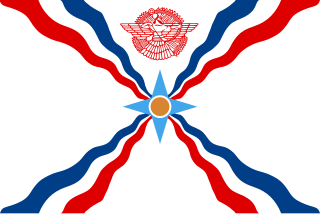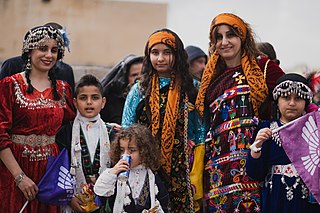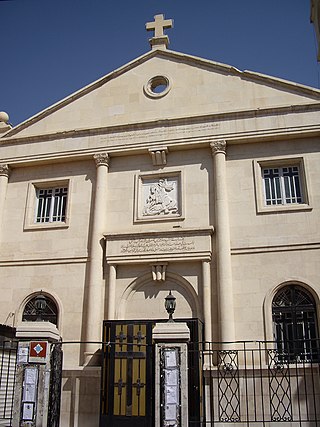Related Research Articles
Aramaic is a Northwest Semitic language that originated in the ancient region of Syria and quickly spread to Mesopotamia, the southern Levant, southeastern Anatolia, Eastern Arabia and Sinai Peninsula, where it has been continually written and spoken in different varieties for over three thousand years.
The Syriac language, also known as Syriac Aramaic and Classical Syriac ܠܫܢܐ ܥܬܝܩܐ, is an Aramaic dialect that emerged during the first century AD from a local Aramaic dialect that was spoken in the ancient region of Osroene, centered in the city of Edessa. During the Early Christian period, it became the main literary language of various Aramaic-speaking Christian communities in the historical region of Ancient Syria and throughout the Near East. As a liturgical language of Syriac Christianity, it gained a prominent role among Eastern Christian communities that used both Eastern Syriac and Western Syriac rites. Following the spread of Syriac Christianity, it also became a liturgical language of eastern Christian communities as far as India and China. It flourished from the 4th to the 8th century, and continued to have an important role during the next centuries, but by the end of the Middle Ages it was gradually reduced to liturgical use, since the role of vernacular language among its native speakers was overtaken by several emerging Neo-Aramaic dialects.

Assyrians are an indigenous ethnic group native to Mesopotamia, a geographical region in West Asia. Modern Assyrians descend from Ancient Mesopotamians such as ancient Assyrians and Babylonians, originating from the ancient indigenous Mesopotamians of Akkad and Sumer, who first developed the civilisation in northern Mesopotamia that would become Assyria in 2600 BCE. Modern Assyrians may culturally self-identify as Syriacs, Chaldeans, or Arameans for religious, geographic, and tribal identification.
The Arameans, or Aramaeans, were an ancient Semitic-speaking people in the Near East that was first recorded in historical sources from the late 12th century BC. The Aramean homeland, sometimes known as the land of Aram, encompassed central regions of modern Syria.

Syriac Christianity is a branch of Eastern Christianity of which formative theological writings and traditional liturgies are expressed in the Classical Syriac language, a variation of the old Aramaic language. In a wider sense, the term can also refer to Aramaic Christianity in general, thus encompassing all Christian traditions that are based on liturgical uses of Aramaic language and its variations, both historical and modern.
Western Neo-Aramaic, more commonly referred to as Siryon, is a modern Western Aramaic language. Today, it is spoken by Christian and Muslim Arameans (Syriacs) in only two villages – Maaloula and Jubb'adin, until the Syrian Civil War also in Bakhʽa – in the Anti-Lebanon Mountains of western Syria. Bakhʽa was completely destroyed during the war and all the survivors fled to other parts of Syria or to Lebanon. Western Neo-Aramaic is believed to be the closest living language to the language of Jesus, whose first language, according to scholarly consensus, was Galilean Aramaic belonging to the Western branch as well; all other remaining Neo-Aramaic languages are of the Eastern branch.

Syriac literature is literature in the Syriac language. It is a tradition going back to the Late Antiquity. It is strongly associated with Syriac Christianity.

The Assyrian diaspora refers to ethnic Assyrians living in communities outside their ancestral homeland. The Eastern Aramaic-speaking Assyrians claim descent from the ancient Assyrians and are one of the few ancient Semitic ethnicities in the Near East who resisted Arabization, Turkification, Persianization and Islamization during and after the Muslim conquest of Iraq, Iran, Syria and Turkey.

The Assyrian homeland, Assyria, refers to the homeland of the Assyrian people within which Assyrian civilisation developed, located in their indigenous Upper Mesopotamia. The territory that forms the Assyrian homeland is, similarly to the rest of Mesopotamia, currently divided between present-day Iraq, Turkey, Iran and Syria. In Iran, the Urmia Plain forms a thin margin of the ancestral Assyrian homeland in the north-west, and the only section of the Assyrian homeland beyond the Mesopotamian region. The majority of Assyrians in Iran currently reside in the capital city, Tehran.
Assyrians/Syriacs in Sweden are citizens and residents of Sweden who are of Assyrian/Syriac descent. There are approximately 150,000 Assyrians/Syriacs in Sweden.

Chaldean Catholics, also known as Chaldeans, Chaldo-Assyrians or Assyro-Chaldeans, are ethnic Assyrian adherents of the Chaldean Catholic Church, which originates from the historic Church of the East.

Terms for Syriac Christians are endonymic (native) and exonymic (foreign) terms, that are used as designations for Syriac Christians, as adherents of Syriac Christianity. In its widest scope, Syriac Christianity encompass all Christian denominations that follow East Syriac Rite or West Syriac Rite, and thus use Classical Syriac as their main liturgical language. Traditional divisions among Syriac Christians along denominational lines are reflected in the use of various theological and ecclesiological designations, both historical and modern. Specific terms such as: Jacobites, Saint Thomas Syrian Christians, Maronites, Melkites, Nasranis, and Nestorians have been used in reference to distinctive groups and branches of Eastern Christianity, including those of Syriac liturgical and linguistic traditions. Some of those terms are polysemic, and their uses have been a subject of terminological disputes between different communities, and also among scholars.

Assyrian nationalism is a movement of the Assyrian people that advocates for independence or autonomy within the regions they inhabit in northern Iraq, northeastern Syria, northwestern Iran, and southeastern Turkey.
The Eastern Aramaic languages have historically developed from the varieties of Aramaic that originated in the core territory of Mesopotamia and further expanded into northern Syria, eastern Arabia and northwestern Iran. This is in contrast to the Western Aramaic varieties found predominantly in the southern Levant, encompassing most parts of modern western Syria and Palestine region. Most speakers are Assyrians, although there is a minority of Mizrahi Jews and Mandaeans who also speak varieties of Eastern Aramaic.
The Assyrian Pentecostal Church, is a Reformed Eastern Christian denomination that began in ethnically Assyrian villages across the Urmia region in northwestern Iran, spreading to the Assyrians living in the adjacent cities, and from there to indigenous Assyrian communities in the Assyrian Homeland, northern Iraq, southeastern Turkey and northeastern Syria.

The Last Assyrians is a 2004 French documentary film by Robert Alaux.
Syriac studies is the study of the Syriac language and Syriac Christianity. A specialist in Syriac studies is known as a Syriacist. Specifically, British, French, and German scholars of the 18th and 19th centuries who were involved in the study of Syriac/Aramaic language and literature were commonly known by this designation, at a time when the Syriac language was little understood outside Assyrian, Syriac Christian and Maronite Christian communities. In Germany the field of study is distinguished between Aramaistik and Neuaramaistik.

Assyrian continuity is the study of continuity between the modern Assyrian people, a Semitic indigenous ethnic, religious and linguistic minority in the Middle East, and the people of ancient Assyria and Mesopotamia generally. Assyrian continuity is a key part of the identity of the modern Assyrian people. No archaeological, genetic, linguistic or written historical evidence exists of the original Assyrian and Mesopotamian population being exterminated, removed, bred out or replaced in the aftermath of the fall of the Assyrian Empire, modern contemporary scholarship "almost unilaterally" supports Assyrian continuity, recognizing the modern Assyrians as the ethnic, linguistic, historical and genetic descendants of the East Assyrian-speaking population of Bronze Age and Iron Age Assyria, and Mesopotamia in general, which were composed of both the old native Assyrian population and of neighbouring settlers in the Assyrian heartland.

The Monastery of Saint Mark is a Syriac Orthodox monastery and church in the Old City of Jerusalem. According to a 6th-century inscription found during a restoration in 1940, the church was built over the ancient site of the house of Mary, mother of St. Mark the Evangelist ; the Syriac Orthodox and other Christians believe that Mary's house was the place of the Last Supper of Christ with His disciples. However, Catholics and other Christians believe that the Last Supper was held at the site of the nearby Cenacle, on Mount Zion.

The Cathedral of Saint George is a Syriac Orthodox cathedral located in Bab Tuma district, in Old Damascus, Syria. The Cathedral acts as the seat of the Syriac Orthodox Church since 1959. It houses the Syriac Orthodox Patriarch of Antioch, currently Ignatius Aphrem II.
References
- ↑ HUGOYE: JOURNAL OF SYRIAC STUDIES Archived 2008-12-22 at the Wayback Machine
- 1 2 Nordgren, Kenneth (2006) Archived 2006-11-06 at the Wayback Machine , "Vems är historien? Historia som medvetande, kultur och handling i det mångkulturella Sverige", pp. 71, ISSN 1653-6894.